The 17th century was a time of great changings in russian church music. The efforts of many theorists were crowned in the famous reform of A.аMezenez, that can be compared with Guidonian reform in Europe. Yet the way to it was long and winding and remains full of mysteries up to now.
The necessity of the reform had been felt since the late 16th century, as the notation had been regarded as not answering its purpose properly. The crew of Mezenez was commissioned directly by the tzar Alexey Mihajlovitch for unification of the church singing. That shows, that the main problem with the notation had been its ambiguity.
The task was seen in making the notation inequivocal. It implied the reformulation of the metalanguage of the theory to suit new demands to the text - i. e. to render the melodies truly and faithfully, restricting the role of oral transmission.
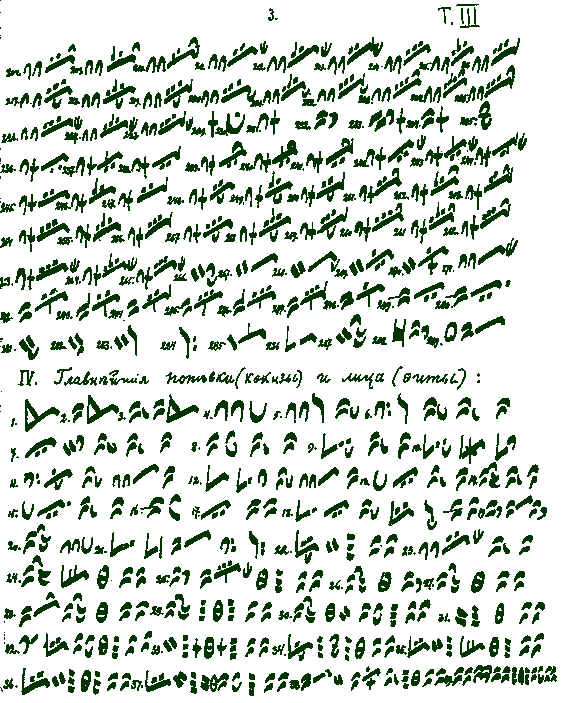
The reform of Mezenez was guided by the spirit of returning to the ancient meaning of the neums, up to the 12аcentury. It was a revision in the proper sense of the word. So Mezenez himself shall be mentionned as a musical paleographist. His invention was rather an attempt to unify the analogous inventions of his immediate and remote forerunners.
The notation of znamenny chant before the 17th century can be called semi-analytical. It has its rigid ideographical formulas, which melodical meaning undergoes changings, depending on the mode and some other circumstances. Their graphical provenience is illustrated in the 3аpart of Neumenkunde of K.аFloros. (On the Pres., №а1, below, you may see the most important formulas) On the other hand it has a number of neums, conceived as more or less independent from the context, their melodical content was mainly exhausted with one single sound. Pitch determination of these latter was the main care of the reformers. On their turn, these non-ideographical neums (after Mezenez one calls them one-sound-neums) were used as transcriptional signs for deciphering, or resolving of ideographical formulas. Such resolvings (rozvody) had been a common practice even before Mezenez.
One distinguishes normally between completely ideographic outlines lizo's and fita's and more flexible popevkas, which graphical-melodical correspondence is more free. In general, the centon character of the chant is not to be denied.
The analytical possibilities of notation were displayed from the first written monuments. They are reflected in the very names, used in azbukas (theoretical compendia from the 15аcentury on) for the neums. Slight graphic modifications allow to distinguish among different specificata of a stem-neum. In the early azbukas the neums are registered, being grouped into the families, each family united around such a stem-neum. This stem neum gives the main (the first) name to the family. Within the family the representatives were distinguished according to many different parameter. See Ill.2 (presentation, №а2). The лrows╗ are the families, the лcolumns╗ exemplify the changings within the families.
These accidental features are reflected in the second names of the neums, and partly explained in the лway of execution╗, attached to each neum of the register. Both second name and description of pronounciating are highly suggestive in regard to pitch. One of attempts to determine the relative (to each other) pitch of the neums is presented on the Picture 3 (presentation, №а3)
Part of these above mentionned graphical modifications were the primordially inherent parts of the neums of byzantic origin. According to their лway of execution╗, one can conclude, that they had been used as the distinctors in regard to some quality. The effect of these modifications upon the stem-neum depended on the neum itself. Graphically these modifications look like a kind of diacritica. They are mostly one, two or three dots, vertically or horizontally set along the neum, or some additional signs of a smaller size. Sometimes they are the degenerated original neums, that had lost its meaning. We don't know, whether this distinctive function had been original, or had been ascribed the signs in retrospect. In both cases the idea of additional signs, лconcretizing╗ the main neums had been generalized.
Graphically all these additional signs form a subset, not depending on the main neums, and generally not crossing with the set of these latter. The dependence concerns only the effect, exercised on the melodic meaning, which was different in each particular case. Sometimes they affected the relative pitch; sometimes they affected the melodic design. Although the scale, or even continuum of the underlying possibilities has been never reported explicitly in the authentical compendia, these additional signs are interesting as an attempt of textual control over the chant.
The 17th century was pregnant with another novice, neglecting the difference between the families in much more radical way. That were the systems of лpomety╗ and лpriznaki╗. These were also the additional signs, set near the main neum, but their effect on the neum didn't depend on the neum and didn't changed its execution (except of its pitch and details of intervallics). From that moment on it has become more comfortable to speak not of specification of the neum within the family or in regard to some лzero╗ level but of its direct appointment to some position within somehow existing scale. The most reliable witness remains the so-called лdvoeznamenniki╗ kind of bilinguas - documents, where the same melodies are presented parallel in neums and staff-notation.
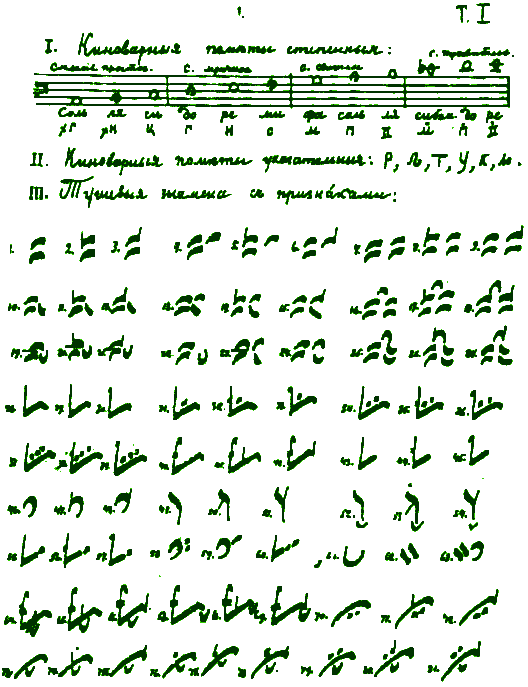
It has been never explicitly discussed in the documents of the period studied, whether the scale should be independent from the neums, used in every particular case. That's why all conclusions, drawn from the documented in staff notation and the dvoeznamenniki, can be applied for the previous period only preliminary. The first documented scales are essentially connected with the adoption of staff notation in general. Both belong to the XVII century and it is not clear in how far the relationship between neums and scale can be generalized. It is not also clear, what has been adopted - the only possible scale, one particular scale, accomplishing totality of the others, or some new way of graphical presentation of scalar possibilities. We don't even know, whether this adoption had been restrictive or deliberating in regard to the chant. In both cases we can't exclude, that the contemporaries of Mezenez could treat this scale in the way very close to that they got used to treat the neums - i. e. as subject to modifications, that could be referred directly or indirectly, or even not referred at all.
The paradoxon is that the notes are welcome to comment on the neums, but prohibited to predict on them. Character of this лstaff-comment╗ is often regarded to be a mere illustration. But the convincing force of this illustration seems to be so great, that it precedes all possible comment. Yet any comment presupposes certain rules of theorizing and particularly in case of scale these are very far from being obvious. The prohibition to predict about the neums express itself in the categorical refusal to use the regularities of the documented scale to explain anything in the chant and to make any retrospect conclusions. So we need staff-notation in order to show the complete independence of the chant from this notation! It can be expressed even more sharply without staff-notation we would never show, how independent is the chant from this notation!
The main reason for that we have no another notation, which would work so effectively. Another reason is the lack of curiosity to investigate, how the neums may serve as a comment on the musical scale one of the most enigmatic лhypertext-neum╗ in the history of mankind and one of the most effective investigative tool, which potentiality is explored so poorly.
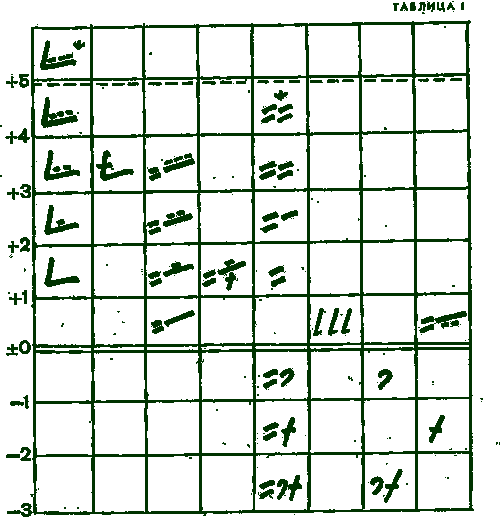
So, if the staff-notation is unfit to explain anything in the chant, why the expression лnot deciphered╗ still means лnot rendered with the staff notation╗? And if we find the staff notation reliable, at least for the historically limited period, we should agree, that an adequate and plausible notation is always to be found. Then the neums are not to лfind their place╗ in some system but rather have to explain the transition, or converting from one system to another. That presupposes a universe of systems, each with the same лillustrative╗ force, and with its own comprehensible staff-notation. That would bring лdeciphering╗ and лunderstanding╗ closer to one another.

The difficulty of the znamenny chant is the diversity of popevkas, characterizing each of its 8аmodes, and the diversity of melodies, hidden under the same graphic outline. The melodical meaning changes from one mode to another, and often even within one mode. In fact, the melodies don't look alike at all while rendered by staff notation (or even deciphered by the one-sound neums). On the other hand, the similar (in staff-notation) melodies are often rendered with different neums (which is not only the problem of different syllable-distribution). Some modes use a number common popevkas, and not only the лparallel╗ ones. That seems to slip out from any comprehension. So more astonishing is the thoroughness, nearly minitiousity, with which different popevkas are explained in the compendia, mostly presented as description of the particular cases of using of the neum given.
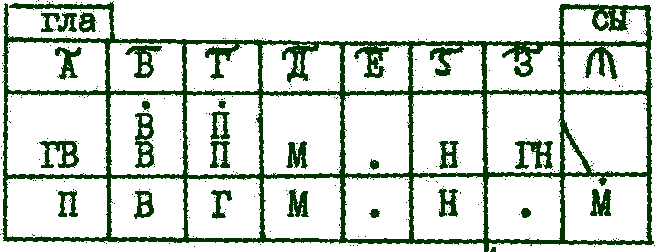
The second difficulty is well documented in the XVII century. It has to do with the pomety and priznaki, i. e. with the additional, specifying signs of the latest generation. The pomety as such haven't emerged at once. They existed long before the reform and had been changing in their composition and number. One distinguishes between the indicative and comparative pomety. The former indicate the duration and character of articulation, the latter are more analytical and allure an relative pitch. The latest compendia, using the dvoeznamenniki, makes the direct translation of these comparative pomety into the staff notation. Ypu may see it on the picture 4.(pres., №а4) The upper row are the pomety.
Yet the problem is, that there were several explanations of this pomety before the лtranslation╗. They don't agree with one another. That makes the final translation to staff rather problematic as an end solution. The following table shows the pomety in a rather unexpected way, if we'd like it to compare with the picture 4. (See pres., №а№а4аand 5)
If on the picture 4аthe six pomety in the middle of the range correspond exactly the Guidonean hexachord, the picture 4a (I haven' sent it) implies them shifted one position higher with corresponding alteration of distribution of tone- and semiton-steps. The melodies, illustrating the effect of pomety, make sometimes even more confusing impression.
The problem, if the 6аpomety can be deduced from a smaller set of pometys with the help of extension or transposition, can't be resolved on its own. The meanings, hidden under the cyrillic letters are not homogen. For example the cyrillic n means лlow╗, which is contraposed to cyrillic v лhigh╗. But we have also the pometa m, which means лdark╗. The term лdark╗ emerges as the second name of the neums of earlier date (from the XV century), and traditionally seen, as sinonym to лlow╗. лP╗ means лto remain on the same place╗ and at the same time it is seen as лsimple╗ deprivated of the qualities, and also is to be set under the лdark╗, if we consult the earlier compendia. On the scale on the picture 3аit is higher than лdark╗. That can mean лpovyshe╗ a bit higher, then лm╗ would mean лmalo povyshe╗ a little bit higher, which implies not even an increasing of the quality but the grade of increasing, and suggests rather a size than a position. The cyrillic g stays for лvery╗ i. e. for increasing of the quality. If applied to лhigh╗ it means either лvery high╗ or лmuch more high╗, applied to лlow╗ it means лvery low╗ or лmuch more lower╗. It is clear, that here we also have a duality of size and relative position. But the same лg╗ had been also hypostazed as the independent degree of the scale with identic up to transposition on the perfect 4аmeaning and no more object of reversion. The cyrillic s, (written as the latin c) stays either for лfast╗ (indicative pometa) or for itself, as the independent degree of the scale. We have also the latin лc╗ transribed by the original cyrillic letter (лzadlo╗), which is normally set a perfect 4аunder лc╗. Moreover, sometimes лc╗ is substituted through the point (.), and this point is sometimes used as the additional sign, specifying the pomety themselves, being set either higher or lower than the pometa. The analoguous competence has the little cross лkryzh╗ an episeme, set sometimes to the lower 3аpometas, which should transpose them a fourth or major second lower. The abudance of the pometas makes some degrees having a double or excess qualification. The following example is taken from the лDrevnerusskaja teorija muzyki╗ of M.аBrazhnikow. It shows the instance of such qualification, whereby it is not clear, if we have 2аnames for the same thing (degree), 2аpositions of the same degree, or 2аdifferent degrees, convergating on the same position, being close to one another, or somehow crossing. (see pomety in the rectangle). (pres., №а6)

The next problem is that the same names лprostoje╗, лmrachnoje╗, лsvetloje╗ simple, dark, bright are traditionally applied to the so-called лsoglasiyas╗ accordances. On the picture 4 (see the brackets) they look as the groups of 3аnotes, divided by the minor second. But Mezenez doen't report anything about intervallics, distinguishing only the degrees within the soglasiye. His лpriznaki╗ (episeme) allow to identify one of three possible positions within the soglasie, but makes no difference between the soglasijas themselves. Nevertheless, the qualifications simple, dark, bright had been never applied to the soglasiyas, neither by Mezenez, nor by the enthusiasts of staff-notation. These qualifications are the interpolation of the later scholars.
All these problems have been widely discussed from the late XIX century and are still discussed now.
Now I'll try to show, what these difficulties have to do with the possibilities of explanation. To begin with I would like you to compare two presentations of the scale on the pictures 3аand 4. The first of them is analytically deduced by the russian musicologist Maxim Brazhnikov from the recommendations, contained in the authentical compendia from the time before 17th century. Analoguous presentation were made by many other scholars for example Zivar Gusseinova, Sergej Frolov, to mention the Saint-Petersburgian. The second one has been already discussed.
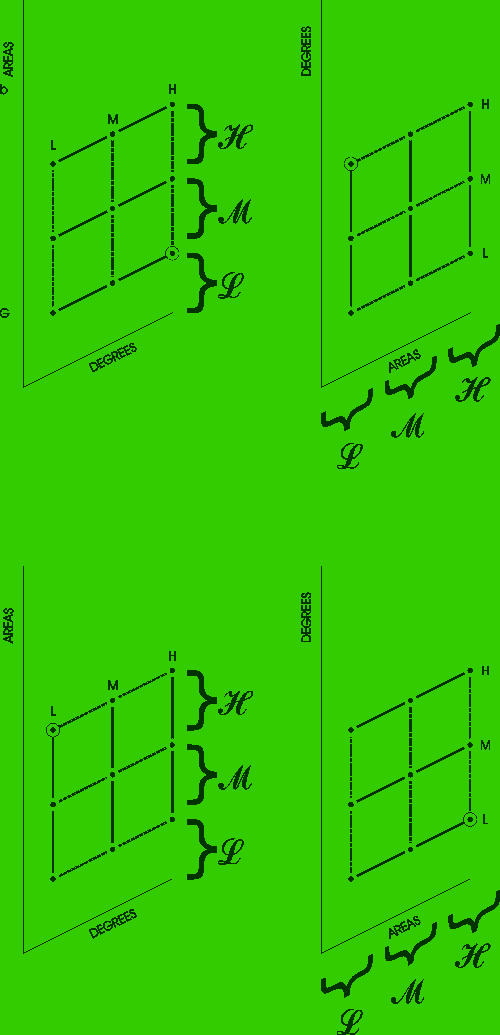
One of them refers to the neums themselves, another - to the pometys, or to specifications of the neums, the second also uses staff notation. These differencies are obvious, but not the most important. Much more important is, that the second one displays the phenomenon of periodicity. it allows quite another questions, concerning its nature. It can be, at least theoretically, extended or reduced in many different senses. I. e. it allows very many discussions - and conclusions - before even mentionning its metrics, or, rudely speaking, the distances between the positions. These conclusions don't loose its force, if the singer is not лin tune╗, if his tune is higher or lower, if the distances deviate from the expected ones. I don't go into question, if this scale should have been borrowed from Guidonean hexachord. The possibility of theorizing before actual hearing is exciting enough to postpone the question, whether it could be invented by one particular person or not. The first scale is not worse, but it can hardly serve as tool of any investigation. It is rather field, than a model. We dont know, whether the distances should underlie some rule, we don't know, what happens, if the whole picture is shifted one position higher and so on. In other words, it allows no syntactical interpretation. The only fixpoint is the so called stroka, or zero-level, to which all other levels are bound. But we dont know, whether this stroka is not movable itself, and if yes, whether its movement are somehow connected with the structure of the scale (if anyone is). It is so, because this stroka has no correlative, it is unic.
But what we do know is, that, taken per se, the melody would be recognized at any height. The musical text may reflect this fact or not, but the musical intuition cant neglect it. But this circumstance makes the competence of the лstroka╗ rather modest.
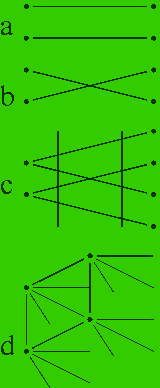
Now, in the second case we have got much more movements verified. For example, we can say for sure, that the structure of the scale wouldn't change, if we shift it a fourth up and down. Then we can distinguish between the shifts on fourth and the shifts on, for example, major second, even without discussion of the exact tonometrical meanings of these intervals. All we need, is the guerantee, that the intervals and their relationships wouldn't depend on their height. So, we can say, that the shift on major second would give another position within the soglasie, (of course, if we retain the three positions, already contained in the scale). We've got even used to say, that this new step would cross the borders of the next soglasie.
Then we can say, that two shifts (transfers) in one direction gives the same new position within the soglasie as one transfer in the opposite direction (cis=des), if the values of major and minor seconds relate as 2аto 1. (By the way, all three statements can be be easily falsified, but now it is important that they can be made, and not just лgo without saying╗).
While describing the neums, the medieval theorists often use the expressions like лhigher╗, лa bit higher╗, лhigh than╗, лlower than╗, лfrom below upwards╗, лin the middle╗, лnot high not low╗ and some similar. What is the semantics of these expressions and are they identic (i. e. - the same in regard to all possible changings of the whole sense of predication)? If we had to do with the corporal phenomena, the answer were probably yes. Moreover, the predications лhigher╗ and лlower╗ would serve one another. If the point A is higher, than the point B, than higher than B and lower than A would mean necessarily between A and B, and making a middle position a bit higher in regard to B would necessarily means a bit less lower in regard to A and making a bit less higher in regard to B means a bit lower toаA.
Then лgetting less higher╗ presupposes an existence of some fixpoint, relatively to which the expression means лgetting lower╗ and vice versa. лBeing high╗ and лgetting high╗ implies the notion of the movement and the general idea of coordinates, so perfectly invented by Descartes as a tool of description of the time with the help of its corporal products and so hardly critisized in 20аcentury. So far with the corporal world, and its mechanical description. I would let the question, if such an approach to regulate the relationships between low and high (dark and light in the objective language of the russian theory) would satisfy the medieval singer (not particularly russian) out of discussion, taking the answer for obvious.
More interesting is the contraposing of darkness and brightness as areas (лoblasti zvuchanija╗) on the one hand and as symbols, indicating some лconcrete╗ pitch values, on the other. This contraposing occurs very often in the investigations on the subject.
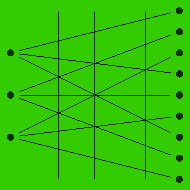
So, how the different лdegrees of being bright or dark╗ could turn into lightly discernarble pitch positions, like on the second (Picture 4) scale? Is it correct at all to speak of such лturning╗, and to embed this process in some historical ranks and attracting the destructive foreign influences?
We see, that instead of one (Picture 3) scale, or increasing of one single quality from darkness to brightness we have a system (Picture 4), distinguishing between increasing and quality, instead of one bright (dark, simple) kriuk, a class, or the scale of bright (dark, simple) kriuks, the same with the other families. Now the problem is, how the scale of the first type could generate the scale of the second type?
The answer is the first presentation can never generate the second one. They give two different pictures of the world physical and mental. The first presents the ordered conglomerate of frequences, the second the system of their logarithms. To return to the discussion about organoglasie and angeloglasie, one can say, that they perfectly illustrate the difference between the corporal and celestial worlds. Even if the second presentation is the invention of the 17th century, it contains the regularities of much more general nature. Yet the idea of one scale generating another one occupe us till the very end of the paper. Certainly they both would be presented logarithmically.

On this, second presentation of the post-mezenez scale (picture 4), we can clearly distinguish between counting of the positions within the soglasie (area) and of the areas themselves. Moreover, if we reverse the axes, the positions and area would be also reversed, we can also draw another crossing sets of parallel collineation, that wouldnt change the tonometrical picture, but totally change its internal structure. Syntactically they would be equivalent, whenever differing greatly from one another in their generic possibilities. It is well seen on the picture 7 (pres., №а7). See the axes лdegrees╗ (=positions) and лareas╗. Brackets with italics are the лcounting╗ instrument L (ow), M (edium), H (igh), the same with the лsquare╗ L, M, H.аObviously, it is not clear without some preliminary conventions what is to be counted first. So if the лkriuk svetlyj╗ (the bright kriuk) is characterizing an area (soglasie, two adjacent major seconds), then it will have three representatives, e. g. лf╗, лg╗, лa╗, which are distinguished from one another with pomety (the marks).
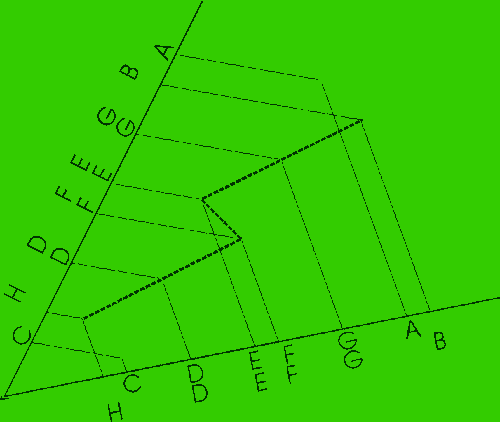
But if the axes are reversed, the three representatives of our soglasie are лd╗, лg╗, лc1╗ and that will be a soglasije of bright kriuks. And the soglasie of the dark kriuks will be лc╗, лf╗, лb╗. Of course, in one particular case of major seconds and perfect fourths this reversing is a trivial abstract speculation. But if we insist, that counting of the major seconds and perfect fourths is essential for the scale (and for the melodic formation), we have to check the behavior of minor thirds and minor seconds (at least of these!), which are the necessary participants of the melodic formation and can't be neglected as a mere epiphenomenon. To verify, for example, the formation of minor thirds, one should connect the corresponding positions with the lines, that would be лdiagonal╗ to our lattice and form the third set of parallel linnes. These modifications are far from being trivial. Still they (and many others) are to be considered, if the theory would like to explain any historical choice, for example, that of Mezenez. Neither major seconds, nor perfect fourths, taken isolated, how ever variable their tonometrical meaning may be, can be responsible for the formation of the chant.
Each system, specified with pair of non-parallel lines and their parallel transfers (giving the regular lattice) would demand its own staff notation. The notations would never agree with one another, and nevertheless, they would all be tonometrically identical, and syntactically legitimate. We've learned about only one of them using major seconds and perfect fourths as parameters. Surely, it will be the same lattice (лtext╗), if the seconds and the fourths are a bit smaller (or broader). I. e., the text will suit some demands, not depending on the real tonometrical values. For example it will still discriminate between лareas╗ and лpositions╗. But what is this tonometrical лbit smaller or broader╗?
On the other hand, if instead of the pair лmajor seconds-perfect fourth╗ we take the pair лminor thirds-perfect fourths╗ the resulting pitch values would be the same, but the lattice will be another one. Is it registered by the names of the neums, by their nomenclature? Or is it hidden under the names and can be revealed only by the analyse of the melodies? As a musician I can't help feeling somewhat uneasy about such things, but as a theorist I m very glad to have found the ways of description of musical phenomena much more fruitful as the common transposition.
The purpose of my paper is not to show all the difficulties and perspectives of the method itself but to show, that this way of theorizing is not only prospective and fruitful, but the most comprehensive, embracing and reconciling all possible ways of theorizing, that seem to exclude one another.
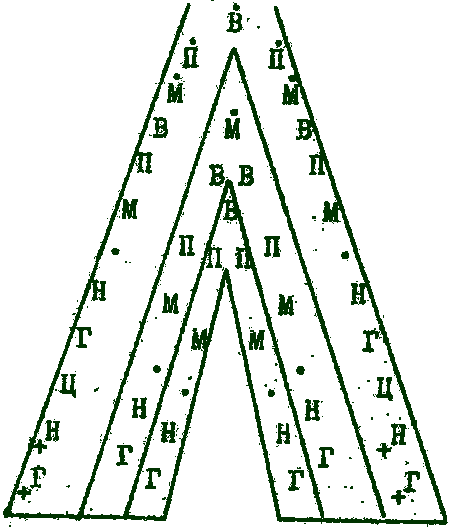
The mentionned duality of area and position, so clearly revealed in the theoretical discourse of the 17th century, reflects more general duality - that of the quality and the universe it is to be applied to. Looking at the table we can distingush between lowest position of the highest area and highest position in the lowest area. We also distingush between higher position in the lower area and lower position in the higher area, independently, whether they are tonometrically higher or lower. E is lower than f, fis is higher than es, yet e and fis belong to another soglasiye as f and es, as long as the syntactical sense of collineation hasn't changed.
Instead of duality лposition-area╗ we can speak of duality лbrightness-height╗. Then we can treat polarities лbright-dark╗ and лlow-high╗ independently from one another, so that the second wouldn't лconcretize╗ the first, and wouldn't demand лmore-less╗ to be concretized itself. However we have to reject the expressions лinside-outside╗, to revise the expression лin the middle╗ We also can't use anymore expressions like лmoving towards to╗, or лmoving away from╗.
Being non-collinear, the continua лdark-bright╗ and лlow-high╗ build a 2dim system, which movements can be verified. On the other hand, they necessarily cross, which has dramatical consequences, for example, for determination of the size of the step. Meanwhile exactly this crossing explains much about generating of one scale from another.
The task of presentation dissipates in two aspects discrete presentation of the scale and continuous presentation of its changing. It is useful to keep this distinction.
| L | H |
| l | h |
The simpliest form of a 2dim presentation of scale contains 2аareas and 2аpositions in each.
The letters stay for areas, the numbers stay for positions. It can be a good model of the scale, alternating 2аdifferent intervals, or even repeating one single interval. The possibilities to iterate this figure are numerous. Actually they form an infinite set, but they don't exhaust all possibilities. The ways of symbolic presentation are also various. For example, if the size of the letter signifies its belongance to the area (soglasie) big for high area and small for low area, then lhLHlhLH would signify both the scale and repeating of 4аnotes. We confrontate the problem of distinguishing different positions of pairs of the areas. Still, if we have a situation лhL╗ or лHl╗ it wouldn't mean any alarm. It would just signify the border of two areas. If we have лlLhH╗ or лLlHh╗ it would mean a zigzag-design. We can use an authentical slavonic term лlomka╗ (fractio). But if we reverse the axes the (size for distinguishing the positions and letters for distinguishing the areas) лzigzag╗ becomes becomes a лscale╗ and vice versa. The different musical figures, for example лdefg╗ and лdfeg╗ would be rendered with the same symbolic notation and the same figure with different notations. If we restrict us to 3аnotes we have either d-e-f-d-e-fЕ or d-f-e-d-f-eЕ which gives a different orientation. That would imply different modes of pronounciation accented (or long) and unaccented (or short) syllables or metrical units of bigger extension. But even that is not so dramatic, under certain conventions the sense of the axials may be recognized. If we have the mode lhLH as the general figure of discrimination between areas and positions (and for the chant that would mean the discrimination of cantillation of the syllable and its position), then the mode hLHl should be necessarily a subordinated one. And that not because the лtone-semitone-tone╗-construction is better than the лsemitone-tone-semitone╗-construction, but just to distinguish hLHl from the LHlh in regard to the лstart-mode╗ lhLH, so not to forget the meaning of the axes. Needless to say, that if the mode of recognition is fixated it doesn't acquire any лquality╗. It is not to be specified. It is. The reversed mode does acquire a specific quality, so is to be marked.
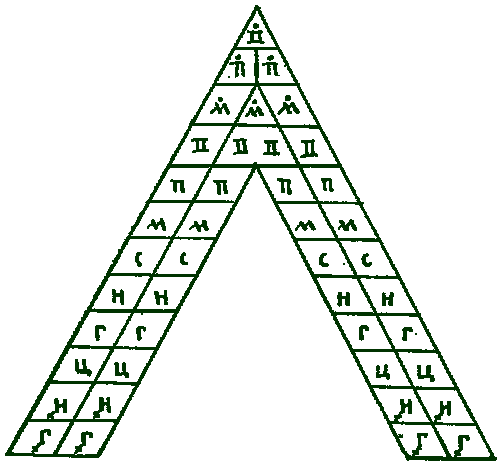
The real problems emerge as soon as we see the lattice, made of the лvertical╗ and the лdiagonal╗ between L and h as concurrent to the лstart-lattice╗. The points are still there, the names are the same, but their meaning has obviously changed and no manipulation with the size of letters and order of counting can register this changing!
Not only лhigh╗ and лlow╗ have changed their meaning. The identity of one structure now exemplifies the changing of another one structure, and vice versa. The state of things becomes an event, and vice versa. The abstract contraposing of two лlevels╗ becomes a melodical step, and what was seen as a melodical step now exemplify the new contraposing, or better to say, the new conditions of melodical formation.
Now we turn to the continuous aspect. We can start with two levels, or positions, say low and high. If they exemplify лhigh and low╗ as areas, each area shall certainly have its own лhigh and low╗. Now what happens, if, trying to avoid this regressum ad infinitum, we let the lines, (exemplifying the continuous changing, or emerging of new divisions of the scale) cross? What does remain and what does change? The polarity inside the pairs, or that between the pairs? It is clear, that the vertical lines look the same and don't register any transfiguration. Two diagonals exemplify both different orientations and continuous changes. See picture 8, left. (pres., №а8аon the left parallels; crossing; both possibilities.) The case with three levels is more complicated.
What takes place before and after crossing (see two vertical лcuts╗ on the drawing below) can be best of all shown as follows. Picture 8, on the right.
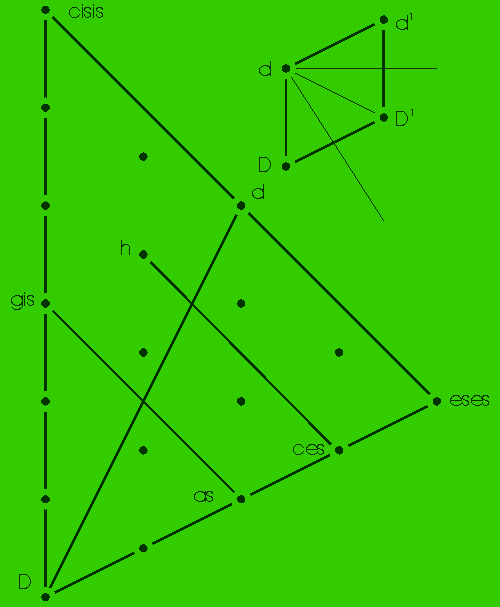
We see, that the angle of projection has changed (three quadruplets of parallel thin lines), and with it also an order of the positions. If we would prolongate each of these quadruplets they would cross any non-parallel straight line in three different orders. These letters are not better or worse than solmisations syllables, or pomety. They are nothing more, than the result of counting.
The case with three levels gives more combinatorical opportunities, one of them you can see on the picture. Picture 9 (pres., №а9, on the left). The distribution of the crossing-points is an invariant of this transformation, it means, that the mutual arrangement of the crossing-points will not change, even if we change the distances between the points on both vertical strokes. It is only required that the divisions on the both strokes should be equidistant.
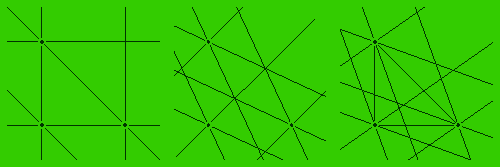
With 9аresulting positions the scope of possibities is rich. Different groupings of the lines correspond different figures in the resulting scheme. The only thing we'd like to demand, is that every point in the resulting scheme participates exactly in one figure, i. e. it shall not be isolated, and it shall not participate more than in one figure. We see, that figures are convex polygons or lines (degenerated polygons).
Now we are close at the question of the meaning of this convexity.
First of all, we ask, what was the reason of grouping of the pomety into these and not another areas. (G, A, H. c, d, e. f, g, a and not the others, for example A, H, c. d, e, f. g, a, b). It is well known, that this grouping was a result of the latest modification, i. e. not of Mezenez, but of Diletzki. Mezenez never used solmization or staff notation. The first answer were - the equidistance of the positions inside of area. However it can be easily falsified. H, d, f, e, g, b, a, c1, es1, are also equidistant. We know the transformation, that leads both equidistant interpretation into one another, and so they are equivalent. The next illustration shows it more clearly. Picture 10 (pres., №а10, above).
The distribution of the letters on the left edge of the picture looks strange but not unsistematical. It is interesting to compare this picture with the famous лgorovoshodnyj holm╗, the graphical presentation of the scale (in different extensions) from the XVII century and to contemplate about the possibilities of the systematical changing of the meaning of the pitch symbols after reflexion around an axis. (Pres., №а№а11, 12). But the matter will not rest here. Now we are going to show, that even the non-equidistant interpretation are quite suitable and equivalent to those both mentionned.
The picture 13, on the left (pres., №а13, left), shows the evolution of the system, where one of the axes may be seen as positions, and the second - as the areas. We are not bound an any tonometrical values, but for the beginning we can suppose major seconds (vertically) and minor thirds (horizontally) respectively. In the corner below we have лD╗.
Now we see, that the same (up to its name) pitch can be achieved лin different places╗. See, for example, лh╗ and лces╗, or лas╗ and лgis╗. лd╗ has on this presentation even 3аdifferent positions. The picture could be accomplished with the d1, but the choice of the octave as a transfer is not principal here, it can be any other interval. Important is, that the collineation, exemplifying any лpitch-ambit╗ (for ex. d-d1) will be necessarilly crossed be the collineation, connecting pair of the лsame pitches in different places╗ (for ex. as and gis). These considerations makes the concept of identity depending on the configuration..
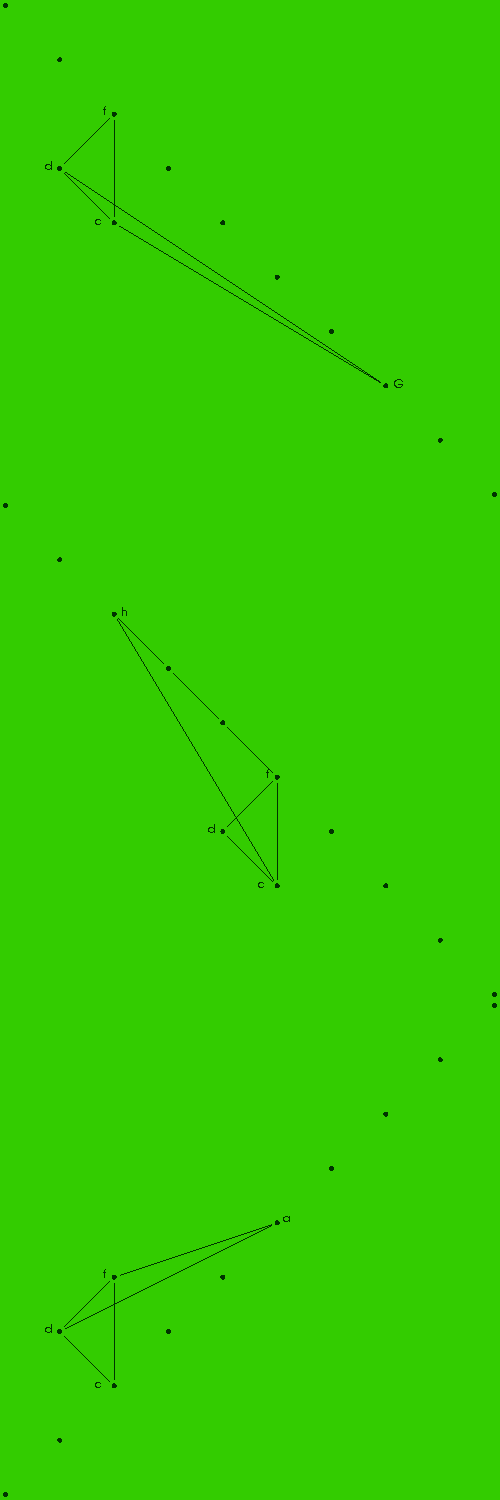
On the right of Picture 13аyou can see the reduced version of the same state of things. We need only 2аsymbols for it (say, d and d1). Three lines not belonging to the romb exemplify 3аdifferent textual states of the scale, for ex. (if we use the conventional notation) d-g-a-d1, d-gis- d1, and d-a-g-d1
Picture 14 (pres., №а14) shows three modes of the state of the scale: the dichord-state (on the left), of the equidistant trichord-state of the scale (in the middle) and the non-equidisitant trichord-state (on the right). The three points are the kind of invariant. They don't exemplify the pitches the tonometrical result (the scale) depends on the angle of the projective straight lines. They project the лtriangle╗ on the qualifying straight line, dividing the latter in in all possible ratios. (This qualifying line is not shown, because it can be chosen quite arbitrarily. The only restriction it shouldn't be parallel with the projective axes themselves). All three pairs (on the left) and three triplets (in the middle and on the right) of projective straight lines are equivalent. That doesn't depend on the angles. Two points of the triangle can be identical (tonometrically or syntactically) only if their collineation coincides with the axis of projection on the one-dimensional scale. In the triangle (Picture 14, left) we have exactly 3аcases of such coincidence, (see the pairs of projecting parallel lines). All these relationships are presented already in the dichord-state of the melody, and can be explained as the relationships of the raspev (intonation) of the syllable, and its position. If we turn the axes of projection, we get a trichord structure of our one-dimensional scale, whereby the inequidistant state of the trichord would continuously go into the equidistant and back. (pictureа14, right and center, the triplets of parallel projective lines are turning, whereby the distance between them constantly changes). What for do we need such equivalence?
Picture 15 (pres., №а15) shows, how лhigher than╗ can never reach лhigh╗, even taken within some ambit. We see 2аtriangles having the common side. If we take this side as an лactual╗ ambit, the point in the лmiddle╗ will be always in the middle, even if it leaves the tonometrical boundaries of the лambit╗. For example, on the left we have both f and G лbetween╗ c and d.
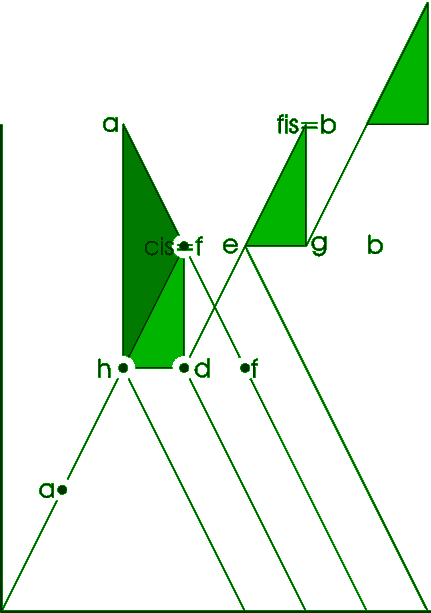
The effectivity of such presentation is, that can say something about the melody even before we exactly know, how many лnotes╗ it has, and what are the intervals, their range and order. It is interesting to compare this competence with the competence of the ideographic neums, that hide obviously quite different (in the staff notation) melodies.
Now we return to our previous tables. We know, that the equidistant presentations of the areas may be projected on the axis differently, and even so, that that, what seems the common sense to be disjoint looks overlapped and vice versa. We know also, that being projected on the both axes, both possibilities even presuppose one another.(see picture 10). But лequidistant╗ remains лequidistant╗, and лwithin the area╗ remains лwithin the area╗, and the borders remain the borders (by the borders the rule of equidistance however doesn't work). But if we try to envolve the system, we get necessarily more than one position, projected on the axis. Picture 16. (pres., №а16) See the collineation, connecting cis and f. What does it mean? Should they be treated as the same, and if yes, then in what sense?
So, if their collineation coincides with the axis of projection they are syntactically the same, but normally it doesn't (we have not many melodies using only equidistant steps). We see, that the marked rectangular triangle exactly shows the degree of deviation of the projective axis from the collineation-in-question, it is absolutely necessary for any metrical analysis, and precedesanymanipalutation with the divisions of the one-dimensional scale (we have already seen, how unreliable they are).
On the first glance, the result we have achieved after such big efforts is pessimistic. There are no reason to see Picture 4аas the authentical evidence. Principle of the equidistance doesn't work. The pomety can be shifted in regard to the лnotes╗ on one or two divisions to the right and to the left. By the way, there is an authentical illustration of such a лshift╗. (picture 4a, that I haven't sent). Brazhnikov sees it as an accident. But it can hardly be conciliated with the usual thoroughness of the scribes.
We can also use the signs of alterations instead, and that corresponds to the possibility of different positions of the clef on the staff. So we become the problems, very close to musica ficta and the pathos of opposition лnatural tuning of russian chant artificial temeperated five-lines european system that destroyed the russian chant╗ looses its foundation.
I'm sorry to constate that. But the records of the modern old believers do it much more convincingly as any abstract considerations. So, we have to admit that the picture 4аpresent only a particular case (if we neglect the possibility of moving the clef). Moreover, even Mezenez, having adopted only one order of using the pomety, restricted the possibilities of explanations rather radical. In other words, if he had adopted any other order, not only the way of deciphering of popevkas, he had undertaken in his compendium, but the very choice of them would be different! It means, that if the popevkas are bound at some specific intervallics and not invariant in regard to the лshift of the semitone╗, the changing of the aspect of theorizing shall redeterminate the whole thesaurus of popevkas, which neglect one class of equivalences and establishes another. But exactly that is the melodical formation- the constant redetermination of the conditions of musical discourse! And that is the optimistical result of our investigation. It allows to build the chains лifЕ thenЕ otherwise╗.
Picture 8аhas shows us, what happens with the figure of tetrachord before and after the crossing. If we return to the Picture 9, we'll see in the left the vertical, connecting the crossing points, and the corresponding situations of the scale, presented on the right. Only two variants from the manifold of possible cadences (=returning to the dichord-state of the melody with the corresponding narrowing of its ambit) are shown. The signs лX╗ means the elimination of the redundant positions.
The detailed comments on the matter is not possible in the ranks of the paper, but the basic principles are shown. It remains only to say, that under this point of view, the process of melodical formation is very much alike the weaving, and the deciphering is similar to unplaiting of the pattern, or even the untying a knot. Even the line (the лzero-level╗) has more affinity with the line of a tailor, than with that of a scribe. Such allusions are not unexpected лknot╗ is a name of a fita of the 1аmodes, some names of popevkas has the same лhandicraft╗ reference. Finally the image of the water, so closely connected with the time and life, is also deep conjunct in the mythological conscience with the weaving, leaving its mysterious patterns in the soul, and resisting every attempt of the material fixation.
So we see ourselves confrontating the necessity quite another statements about the musical matters, where we have to reject the usual way of speaking and to learn another, more comprehensive one.
The effictiveness of the presentation with the help of diagramms is not only economizing of the speech about the music (whereby it is important enough, as we have to deal with invariants not depending on the amount of notes of some giving melody, or range of its interval, and so, don't depend on some arbitrary conventions) but it also help to find the solution, how the melody is developped and what combinatorical potential it has.
These methods open the way to the comprehensive morphogenetical studies of melodies. It makes superfluous competence of many distinctions, such as proceeding-in-time (melody-step), proceeding in no-time (pitch-indication), proceeding out-of-time (indirect indication of modality, for ex. athona).
The main idea of the paper and the general approach are inspired by the Saint-Petersburger organologist and musicologist Felix Raudonikas, who held the seminar лMusical syntax at the State university in 2001-02аacademical years.
The purpose of the paper was neither to deny nor to prove the byzantic origin of znamenny chant. It was neither to bless nor to blame (in retrospect) the European influence in the XVII century. The paradigm of such question seems to be rather narrow. Besides of that it is hardly to imagine any theorist from any century that would like to invent the original Russian theory and notation, to substantialize it, without being acquainted with different theories and different notations, without having any idea of principal diversity of such possibilities. So the more independent is the particular system to be developed the more general are its principles. It presupposes rather high level of reflection and abstraction. The questions raised in the paper are of genuine musical nature and are acute for anybody trying to interpret the neums be that a singer, a scholar, a scribe, not depending on the щpoque he belongs to. This strange, self-denying character of the text, of the лdrawing of the time╗ that always contradicts itself should be also clear to the medieval singers, who obviously relied themselves upon the oral transmission, than an any written knowledge and that with a good reason. Each example codification of the chant, of its grammar and vocabulary abolish the suspicion in naivety of the лcodificator╗ ipso facto.
The formalities revealed in the paper allow using the possibilities of formal presentation rather extensively. It demands the despecification of the scale, displayed by the usual staff-notation and retaining its more general, and more important (than the tonometry) principles. It concerns not only the number of the lines or лdistances╗ between them, but also such useful instruments of investigation as signs of alteration (with rather wide scope of meanings). There are also some graphical details of staff interpretation that could be used systematically. They refer to the registration of different types of syntactical equivalence.